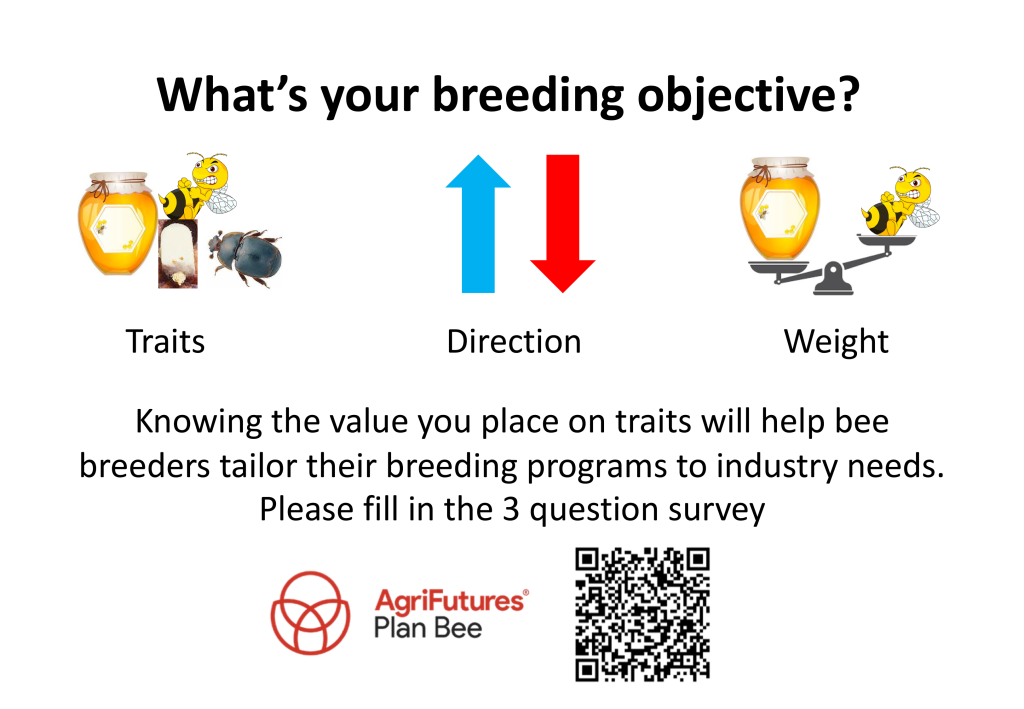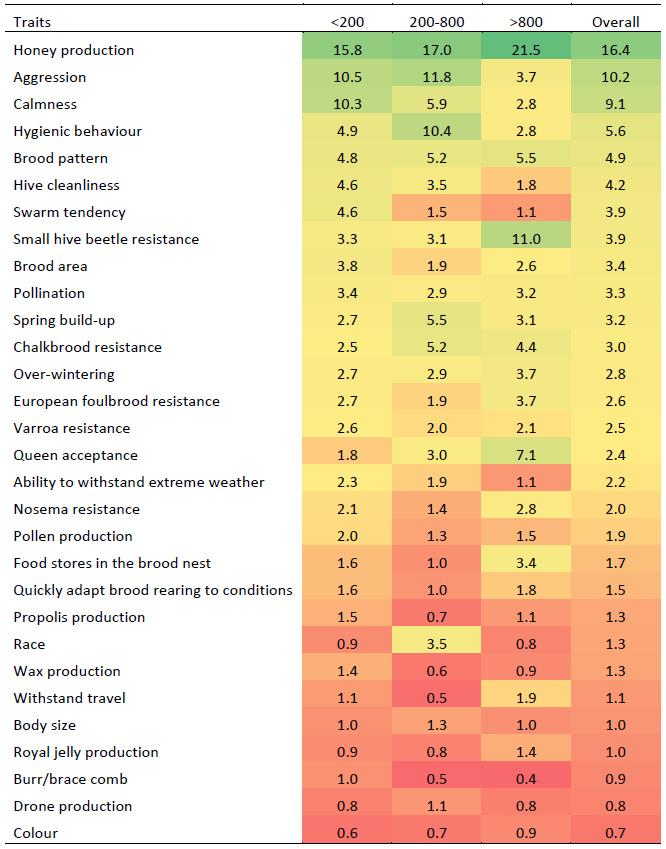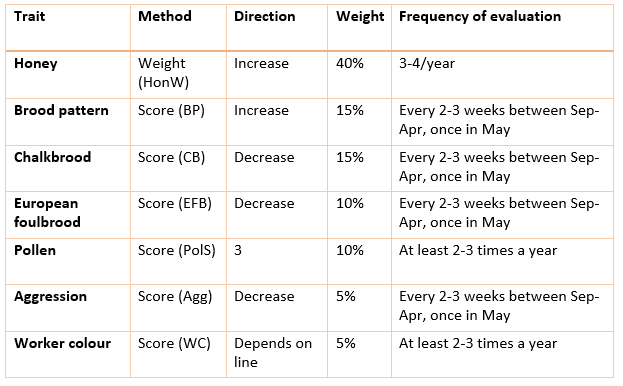Plan Bee is Australia’s honey bee genetic improvement program. Any bee breeder can participate. They have control over their breeding objectives. They can have a different breeding objective for different stock.
What is a breeding objective?
A breeding objective includes:
- The traits to be selected
- Which direction you want to select each trait for
- Whether traits are treated equally, or more weight is given to some traits and less to others

Traits
There are a large number of traits that Australian beekeepers are interested in. Honey production is considered the most important trait (Table 1).
Table 1. Relative importance (%) of traits to recreational/semi-commercial (<200 colonies), commercial (200-800 colonies), and large commercial (>800 colonies) beekeepers. Cells are coded based on importance from high (green) to low (red). Results from 2021 Plan Bee survey

Download Table 1. Relative importance of traits for Australian beekeepers
While there may be many traits of interest, there are not appropriate methods of selection for all of them. The Plan Bee Breeding Manual details the traits and the methods available for assessing traits in the program.
The more traits that are under selection the less progress that can be made on each one. It is therefore important to understand that it will not be possible to make a bee that has every trait. A reasonable breeding objective would include up to 6 traits.
Direction
Bee breeders can choose the direction in which they want to select traits. Breeders direct selection either to increase or decrease a trait. There are some traits, such as pest and disease incidence, that all beekeepers would agree should be selected for a decrease. However, there are disagreements over the direction of selection for other traits, such as propolis and pollen production.
Alternatively, bee breeders can select for a particular score. If a trait is scored on a scale of 1 (low) to 5 (high), the bee breeder could choose, for example, to select for a medium score (3).
Weighting
Bee breeders can keep things simple and give equal weighting to all traits. Alternatively, they can give more weighting to some traits and less to others. The weighting given to traits will change the outcomes in terms of the Estimated Breeding Values assigned. However, an EBV will be generated for each trait, so the bee breeder will have all the information to make their final decisions.
Other considerations
Bee breeders should also make plans for how many colonies they will assess and how many times they will assess them per season.
Some traits vary a lot due to weather and resource availability. Taking one measure only may therefore not be very accurate. Examples are aggression and hygienic behaviour. Assessing such traits only once may result in inaccurate information, and therefore inaccurate breeding decisions. Doing them twice is an improvement, doing them three times is even better.
Likely the most important thing for bee breeders is how much time it costs to produce each queen versus how much they sell for. They need to have profitable businesses, that’s why it’s important that Plan Bee ensures they have control over their breeding objective.
An example
Plan Bee has a breeding population of 250 colonies at Tocal Agricultural College. The breeding objective is below (Table 2). However, we also evaluate a number of other traits: frames of bees, brood area, honey area, pollen area, propolis, and incidence of other pests and diseases.
Table 2. Tocal Agricultural College breeding objective

What’s your breeding objective?
Plan Bee is collecting data on breeding objectives from beekeepers and bee breeders. This market research will be beneficial for bee breeders so that they know what their customers are looking for. Please fill in the 3 question survey.
Video: Breeding objectives, Meat and Livestock Australia
Acknowledgements:
- Plan Bee (National Honey Bee Genetic Improvement Program) is supported by funding from the Australian Government Department of Agriculture, Water and the Environment as part of its Rural Research and Development for Profit program. The project is further supported by AgriFutures Australia, the Department of Regional NSW, University of Sydney, University of New England Animal Genetics and Breeding Unit, Better Bees WA Inc, Wheen Bee Foundation, Costa Group, Olam, Beechworth Honey, Monson’s Honey and Pollination, South Pacific Seeds, Australian Queen Bee Breeders Association, Australian Honey Bee Industry Council, and commercial beekeepers.
- Chapman & Frost (2021) Plan Bee Breeding Manual version 1. AgriFutures Australia
- Survey: https://redcap.sydney.edu.au/surveys/?s=MDX9HNJWCFWDX94W available until 30/09/22
- This article was peer-reviewed by Elizabeth Frost and Erica Mo.
- The main image at the top of the article shows a Tocal Agricultural College Carniolan queen.


